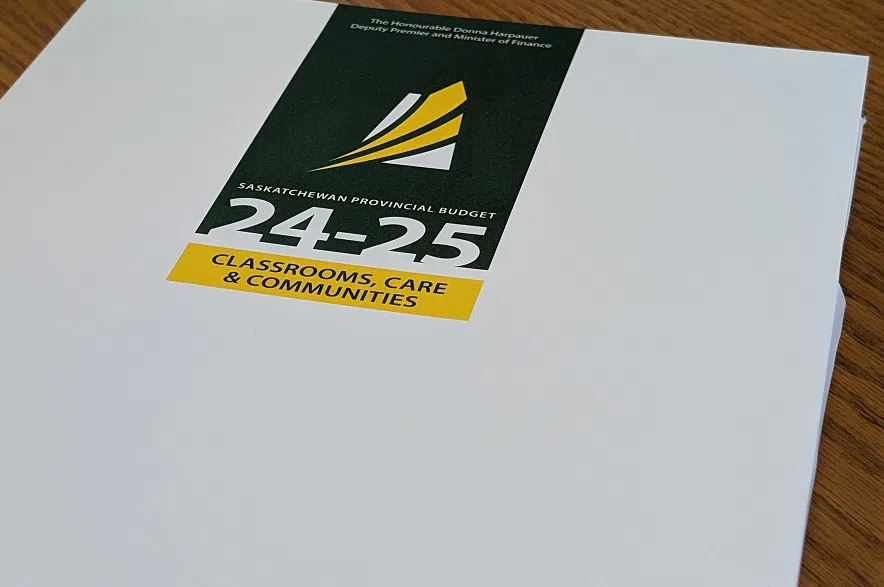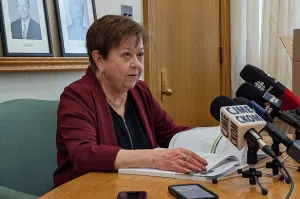The Government of Saskatchewan tabled its provincial budget Wednesday afternoon, outlining its revenue, spending and priorities for the year ahead.
Here’s what you need to know:
Classrooms
Thanks to a pre-budget reveal by the premier and a deal struck with the Saskatchewan School Boards Association, the education portion of the budget had largely been announced prior to Wednesday.
Education funding is $3.3 billion overall, which includes $2.2 billion in operating funding for Saskatchewan’s 27 school divisions.
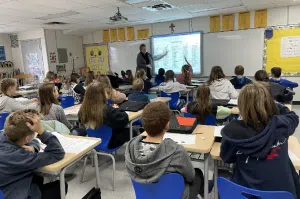
The provincial budget includes measures to address the issues around class size and complexity which have been the major sticking point in the government’s stalled negotiations with the Saskatchewan Teachers’ Federation. (Libby Gray/650 CKOM)
But as Finance Minister Donna Harpauer delivered her budget address in the chamber of the Legislative Building in Regina, teachers were picketing on the steps outside.
The government and Saskatchewan Teachers’ Federation have been deadlocked in contract negotiations, with the union pushing for a new collective agreement to include stipulations on class size and classroom complexity.
The budget includes $356.6 million for classroom supports specifically to address classroom size and complexity. That’s up $45.6 million or 14.7 per cent from last year. Nearly $5 million is set aside for the previously announced teacher innovation and support pilot program and the specialized support classroom pilot.
“We are investing in what teachers and students have told us matter the most,” Harpauer said.
But while the new funding may help the situation in classrooms, the federation has said the money could be clawed back after the fall election unless it’s written into a new teacher contract.
New Schools
Nine new schools and two renovations are announced in this budget.
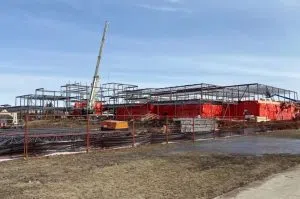
Construction is continuing on the joint-use school that is to replace Imperial Community School and McDermid Community School on the public side and St. Peter School and St. Michael Community School on the Catholic side. (980 CJME file photo)
The list includes a new joint-use high school for Regina’s east end.
It’s the first high school to be built in the Queen City in more than 20 years, and will be the biggest school ever built in the province.
Saskatoon doesn’t miss out, with a new joint-use high school for the Bridge City’s east end also included in the budget.
The other new schools are replacing Minahik Waskahigan High School in Pinehouse, a joint-use elementary school in Saskatoon’s Brighton neighbourhood and renovations for South Corman Park School and Swift Current Comprehensive High School.
Add $28.5 million for relocatable classrooms and the continuation of 11 previously announced school projects and the government believes this will go a long way to planning classroom size into the future.
Taxes
There are no new taxes nor tax increases in this budget. But the government said it keeps things affordable for residents by maintaining the country’s lowest personal income tax, along with the continuation of the active families benefit, the children’s drug plan, and programs to help fund insulin pumps and glucose monitors.
Harpauer said she was pleased to table a budget that didn’t include any tax hikes, but said it’s a tricky balancing act.
“You can only forgo a certain amount of revenue and still be able to support health care, education and other services,” the finance minister said.
“So it is a balance of trying to keep the taxes low enough that we’re as low as we can be. but still at the revenue available to support services.”
The government claims Saskatchewan families have saved about $400 on average since it made the decision to withhold the carbon tax on home heating, a drop of nearly eight per cent for the average residential customer.
The reduction in Saskatchewan’s small business tax – to one per cent – will be extended until June of 2025, which will make life a bit easier for small business owners around the province.
Health
Health care gets the largest portion of the overall budget, with $7.6 billion set aside, $4.7 billion of that for the Saskatchewan Health Authority.
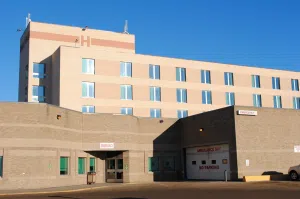
Funding for a major upgrade at Prince Albert’s Victoria Hospital was included in the budget. (paNOW file photo)
There is $516.8 million allocated for health infrastructure, such as new hospitals and health-care centres, none of which is new. It’s an increase of $179.3 million from the previous year and includes $180 million for the Prince Albert Victoria Hospital, $55 million for the Weyburn General Hospital replacement project, $27 million for construction of the La Ronge long-term care project, and $21.9 million to complete construction of the Regina General Hospital parkade.
After Saskatchewan had to send some patients to Calgary for breast cancer diagnostic services this year, the budget contains $3.5 million for the Breast Health Centre in Regina, which will allow patients to access those services a lot closer to home. The centre, which will be located at Regina Centre Crossing on Albert Street, is expected to open during this fiscal year.
The government is aiming to exceed last year’s record total of more than 90,000 surgical procedures, and to ensure that 90 per cent of operations are done within 10 months of the patient being told they need surgery.
This year’s budget also includes $574 million to fund programs and services for those struggling with mental health and addictions. That’s more than seven per cent of the total health-care budget, and the province’s largest-ever investment in that area.
Agriculture
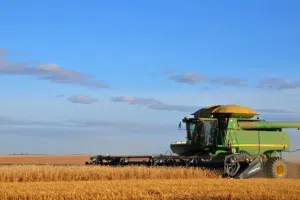
Farmers in some parts of the province are preparing for their second drought year in a row. (650 CKOM file photo)
The projected surplus in last year’s budget was largely reduced thanks to a drop in revenues, part of which came in response to drought and crop insurance payments.
The threat of a dry season exists in 2024 after such a mild winter. There is $431.7 million allocated to fund federal-provincial risk management programs, including crop insurance and Agri-stability.
That’s an increase of $23.7 million from the year before.
Harpauer said the funding is in place to address another dry season for producers.
Deficit
The government continues to spend more than it is taking in, with projected revenues of $19.9 billion and expenses of $20.1 billion.
The deficit is projected to be $273.2 million. The finance minister said she was comfortable with that, calling it “a small and modest” deficit.
Saskatchewan’s population is expected to surpass 1.25 million later this year, and Harpauer said the government has to spend more as a result in order to ensure services are in place and needs are met.
“This budget addresses the challenges of a growing province by reinvesting the benefits of growth in the areas that matter most to Saskatchewan people – education, health and our communities,” she said.
A surplus is predicted to return in the next budget year, but Harpuer, who isn’t running in the fall election, won’t be the one to deliver it.
“I would have loved to have ended with a last budget that was balanced and able to do a tax reduction,” Harpauer told reporters on Wednesday.
“However, it is budget that I am comfortable with.”
Saskatchewan’s total debt is now $34.8 billion. There is no planned payment to reduce that in this budget. If resource revenue increases through the year, that’s largely where the money would go.
But that won’t sit well with the Saskatchewan NDP or the Canadian Taxpayers Federation, as both groups called for the government to focus on reducing provincial debt in the budget. Despite those calls, the budget doesn’t include any debt-reduction measures.
